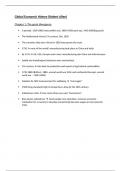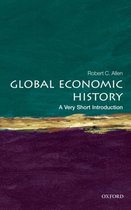Global Economic History (Robert Allen)
Chapter 1: The great divergence
3 periods: 1500-1800 (mercantilist era), 1800-1900(catch-up), 1900-2000(big push)
The Netherlands richest 17e century, 18e, 1820
The countries that were richest in 1820 have grown the most.
1750 most of the world’s manufacturing took place in China and India
By 1913 UK, USA, Europe much more manufacturing dan China and India because
textile and metallurgical industries were mechanized.
19e century Asia back to production and export of agricultural commodities
1750-1880 (Britten), 1880- second world war (USA and continental Europe), second
word war – 1980 (USSR)
Solution for GDP measurement for wellbeing “real wages”
1500 living standards high in Europe but a drop by the 18th century.
Subsistence ratio how many times you earn “bare-bones”.
Bare-bones subsistence short people, less education, removes economic
motivation for a country to develop economically because wages are low (poverty
trap).
,Chapter 2: The Rise of the West
Certain cultural factors, such as widespread literacy and numeracy have been
necessary conditions for economic success since the 17th century.
Smith: Absolutist monarchies stifle economic activity by prohibiting international
trade, threatening property. Smithian growth: through division of labor production
becomes more efficient by specializing in specific parts of production process.
First globalization: invention of full-rigged ships expanded markets, led to Voyages of
Discovery. (start “The great divergence”)
Full-rigged ships 15th century: English and Dutch drove Italians out of business (cloth
industry)
Unequal development: because of technological change, globalization, and economic
policy
Latin America yielded a lot of silver. Silver imports in Spain led to high inflation (the
price revolution). As a result, Spanish agriculture and manufacturing became
uncompetitive. It provided cash for the Europeans to buy Asian goods.
English and Dutch trade with their colonies drove their economies forward. Cities
and export-oriented manufacturing grew. The growth in urbanization and rural
manufacturing increased the demand for labour and led to tight labour markets and
high wages. Living standards were high in London and Amsterdam. The growing
urban demand led to agricultural and energy revolution. Output per farm worker
increased, substitute fuels were developed. The high-wage economy generated a
high level of literacy, numeracy, and skill formation in north-western Europe.
Expansion of commerce and manufacturing made education economically valuable,
the high-wage economy provided money to pay for schooling. They needed food for
the workers so agricultural revolution in England and the Netherlands. (output per
farm worker 50% increase). Netherlands peat and England coal (cheapest
energy in the world)
In 1500, Italy and Spain were the most advanced economies.
From 16th century on, England the most rapidly urbanizing country in Europe
A rise in literacy in north-western Europe due to the high-wage, commercial
economy
, Chapter 3: The Industrial Revolution (1760-1850)
Technological change was the motor of the industrial revolution
The Industrial Revolution took place in a particular political and cultural context that
was favorable to innovation. The English state collected about twice as much per
person as the French state and spent a larger fraction of the national income
(promoted economic growth, strong army and navy). Parliament’s power to take
people’s property allowed for profitable irrigation projects. This was not possible in
France. Most taxes from England were raised from excise duties on consumer goods
like beer and imports like sugar and tobacco. No representation of workers in
Parliament. Parliament had power to take people’s property against their wishes (not
possible in France).
The Scientific Revolution of the 17th century led to discoveries that were applied by
inventors in the 18th.
Britain’s high-wage, cheap-energy economy made it profitable for British firms to
invent and use the breakthrough technologies of the Industrial Revolution. By the
middle of the 18th century, labor relative to capital was 60% more expensive in
England than on the continent. As a result, businesses in England found it profitable
to use technology that saved on expensive labor by increasing the use of cheap
energy and capital. With more capital and energy at their disposal, British workers
became more productive, the secret of economic growth. In Asia and Africa, the
cheapness of labor led to the opposite result.
17th century China and India largest cotton industries
International competition led to the mechanization of cotton spinning (1760’s first
commercial spinning jenny). These machines owed nothing to scientific discoveries.
None involved great conceptual leaps; instead, they required years of experimental
engineering to come up with. The reason why the Industrial Revolution started in
Britain, is that the machines they invented increased the use of capital to save labor
(a lot of R&D). Consequently, they were profitable to use where labor was expensive
and capital was cheap, that is, in England. Nowhere else were the machines
profitable.
By the 1820s, improved cotton machinery could be profitably installed on the
continent, and by the 1850s, it proved profitable to install even more improved
machinery in low-wage economies.
1712 first steam engine, 1730 “general use”, 1840 improved engine. Was used to
drain mines (Britain), burned a lot of coal (Britain), 1785 first large scale steam
powered factory (maar meeste nog watergedreven tot 1840)
1804 first steam locomotive





